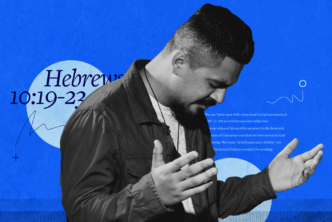One of my favorite applications of discourse grammar is reading the Synoptic gospels, well, synoptically. Mathew, Mark and Luke have enough overlapping content that scholars often study the stories in parallel using what’s called a synopsis. This is the idea behind the Parallel Gospel Reader interactive in Logos 6. Where the gospels differ from one another, some scholars have claimed the differences stem from a hypothetical gospel source called Q. Much of what is attributed to Q could just as easily be understood as adaptation by the gospel writer from the standpoint of discourse grammar. Take a look at the differences between in how John the Baptist describes Jesus in Mark 1:7–8 compared to Luke 3:16 and Matthew 3:11. Each writer presents the same basic information in a slightly different way, which in turn affects how Jesus is portrayed. Mark 1:7 begins by introducing Jesus and then moves on to comparing Jesus’s ministry to his own.
Mark’s version describes Jesus as “one more powerful than me” who is coming, whose sandal thongs he is not worthy to untie.
Luke’s version begins by describing John the Baptist’s own ministry before introducing Jesus. The intro, virtually the same as Mark’s, ends up delaying the contrasting portrait of Jesus’s baptism with the Holy Spirit. Luke also signals that another related piece is coming through the inclusion of the particle μέν. It is the grammatical equivalent of a shipping label saying “Item 1 of 2.” We expect that some related element will follow. Here is Luke 3:16:
We also see Luke change the order of John’s first statement to add emphasis: “I with water baptize you,” as Yoda would say. The emphasis serves as a foil for the contrasting statement about Jesus. He also baptizes, but with a different means than John’s water. Again, these are not huge changes, but they certainly add rhetorical impact compared to Mark.
Matthew changes the proposition around slightly, but with dramatic effect. Like Luke he begins with John’s characterization of his ministry introduced with a prospective μέν. But he also adds a purpose for his baptism: repentance. And where Mark and Luke characterize Jesus as “one more powerful who is coming,” Matthew inverts this to “the coming one who is more powerful.” Same concepts and ideas, but different formulations to create different portraits. Take a look at Matt 3:11:
Matthew also applies emphasis differently than Luke. Where Luke omitted the comment about Jesus coming after John, Mathew retains and emphasizes it. The shift from “coming” as the action to “being stronger” spotlights it compared to it just being a quality of the person coming. The inclusion of the verb ἐστιν “is” allows Matthew to show “more powerful than me” is emphasized compared to a simple verbless clause.
Finally there is the parallelism between the contrasting descriptions of the baptisms. Matthew’s version adds two details about each baptism whereas Mark and Luke only include one. We have two people—John the Baptist and Jesus—doing the same action—baptizing. The most important part of the contrast is the final details about the means. The particle μέν ensures that readers know to connect these critical parts. Even though their ministries might appear similar, John’s speech highlights the critical differences.
All three writers convey the same basic content; we have synoptic consistency. But each, it appears, shapes their version to highlight or prioritize details based on their individual purposes. Attributing the differences to lost Q sayings ignores the more important exegetical question, namely phrase it this way and not that way?
This quick analysis shows that there is more going on here than stylistic variation or idiosyncratic writing, especially for those who believe these writings are inspired. Discourse grammar holds great potential for addressing issues like these, both in the pulpit and in the Academy.
If you have had some Greek and are longing to dig deeper into issues like these, then it’s time to dive into discourse grammar. And there is no easier or more effective way to get started than the New Testament Greek Discourse Bundle from Logos.








